Does your home feel too perfect, too polished, and lacking the warmth that makes a space truly yours? Wabi sabi interior design offers a refreshing way to create rooms that feel calmer, more genuine, and deeply personal.
This approach helps you stop chasing expensive perfection and start appreciating what you already have in your space.
I’ve found that homes designed with wabi sabi principles feel more relaxing because they don’t demand constant maintenance or updates.
You’ll spend less money replacing things and more time enjoying rooms that reflect your real life and experiences. Let me show you why this gentle approach might be exactly what your home needs right now.
What is Wabi-Sabi Interior Design?
Wabi-sabi is a Japanese design philosophy that celebrates imperfection, simplicity, and the natural beauty found in aging materials. It teaches you to appreciate things as they are rather than chasing flawless perfection in your home.
This style welcomes worn textures, handmade items, and organic shapes that tell stories of time passing gracefully.
You’ll see natural materials like wood, stone, clay, and linen used throughout wabi-sabi spaces for their original character. The color palette stays neutral with soft browns, taupe, sand, gray, and muted greens that create calm.
Unlike strict minimalism that feels cold, wabi-sabi brings emotional warmth and soul into every room you design. It’s about finding peace in simplicity while honoring the unique marks that make each piece special.
Wabi-Sabi Interior Design Principles to Follow
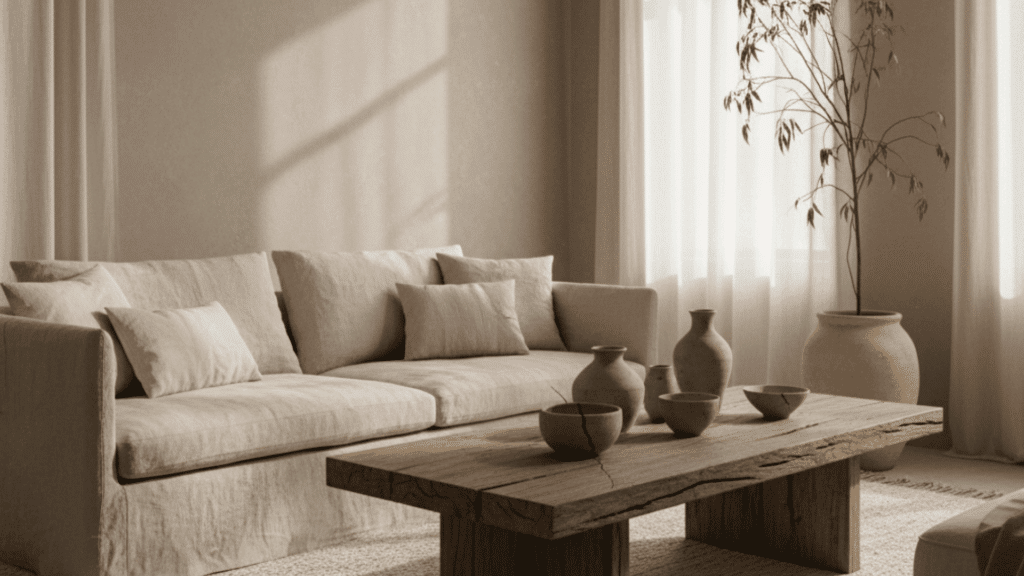
Wabi-sabi design follows six key principles that I use to create calm, genuine spaces filled with character and warmth. These guidelines will show you how to welcome imperfection and natural beauty in every part of your home:
1. Embrace Imperfection
True Wabi-Sabi design values the beauty of cracks, uneven textures, and natural wear. My friend Sara, a ceramic artist, loves how her handmade pieces show small flaws that make each one unique.
I recommend choosing decor that tells a story rather than chasing perfect finishes. “A chipped mug can feel more alive than a new one,” she once said, and I completely agree.
2. Simplify Your Space
Wabi-Sabi encourages living with intention and meaning. My neighbor Liam cleared half his living room shelves and instantly noticed how calm the space felt.
I’ve seen how simplicity changes how you use your home; it becomes lighter, quieter, and more relaxing. Experts say to remove items that don’t add comfort or purpose. Start with one corner and let it grow from there.
3. Use Natural and Raw Materials
Raw textures like wood, stone, and linen bring warmth and honesty to interiors. I recommend combining rough and soft finishes for balance, such as pairing linen drapes with a reclaimed wood table.
Designers often say natural materials connect you to your surroundings better than synthetic ones ever could. “The more imperfect the grain or weave, the more life it has,” my colleague once told me.
4. Create Warm, Muted Color Palettes
Earthy tones such as clay, beige, and moss define Wabi-Sabi interiors. I’ve seen how these shades create calm, timeless rooms that don’t need constant refreshing.
Experts suggest layering similar tones instead of sharp contrasts for a softer depth. My neighbor Julia painted her walls in muted taupe, and the space now feels restful at any time of day.
5. Focus on Light and Space
Natural light plays a major role in creating peace indoors. I recommend using soft, sheer curtains instead of thick blinds to let sunlight filter gently.
My friend Emma, an interior stylist, swears by warm-toned bulbs that make rooms glow naturally after sunset. Open space matters too; leave breathing room between objects to let your home feel balanced and calm.
6. Celebrate Age and Originality
Aged furniture and heirloom pieces embody true Wabi-Sabi character. I’ve seen old wooden tables with scratches look more inviting than brand-new ones. Experts encourage embracing patina as a mark of history and love, not damage.
My uncle’s vintage sideboard, passed down through generations, gives his living room warmth and meaning that modern furniture just can’t replicate.
Applying Wabi-Sabi Design Room by Room
Each room in your home offers a unique chance to bring wabi-sabi principles to life through thoughtful choices. Here’s how to apply this design philosophy in different spaces with specific materials, colors, and lighting:
1. Living Room
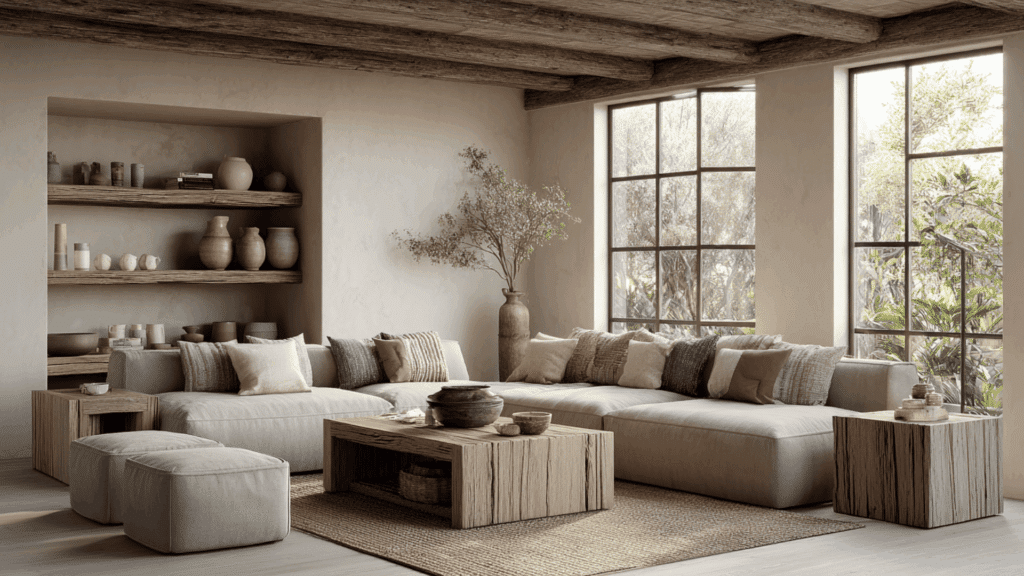
Low seating paired with layered textures instantly makes your living room feel welcoming and comfortable for long conversations. Handmade ceramics displayed on shelves tell stories while natural fiber rugs anchor the space with earthy charm.
Linen, jute, and reclaimed wood blend together to create an unpretentious atmosphere that celebrates everyday life. Beige and taupe tones flow seamlessly throughout, improved by natural daylight and warm evening bulbs.
2. Bedroom
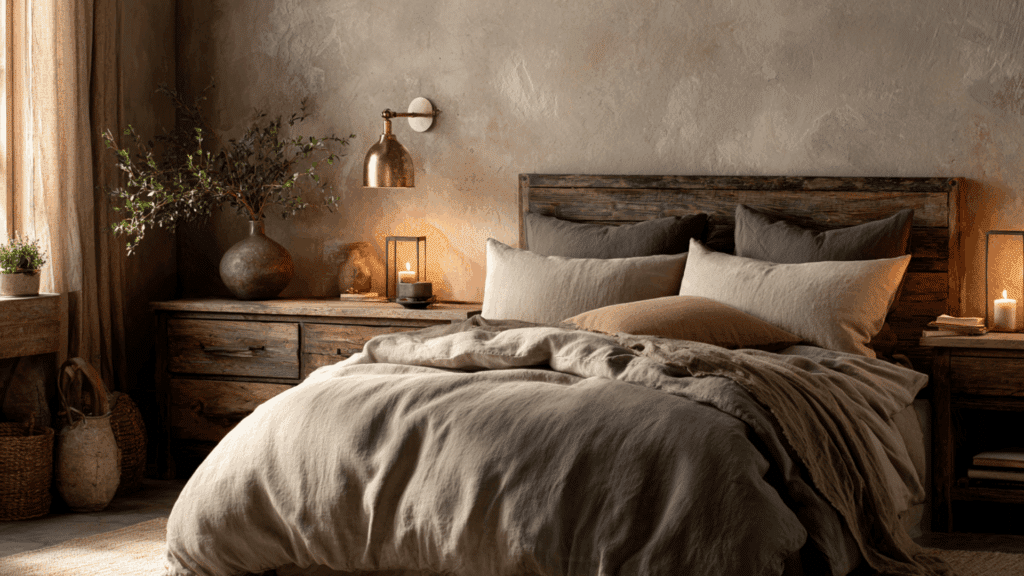
Soft bedding in linen or cotton wraps you in comfort while aged wood nightstands showcase beautiful grain patterns. Vintage brass lamps cast a gentle glow that highlights the sand and pale gray palette surrounding your bed.
Muted olive touches add quiet color without disrupting the restful mood you need for quality sleep. Dimmable fixtures let you control ambiance perfectly as you unwind each night before sleeping.
3. Kitchen
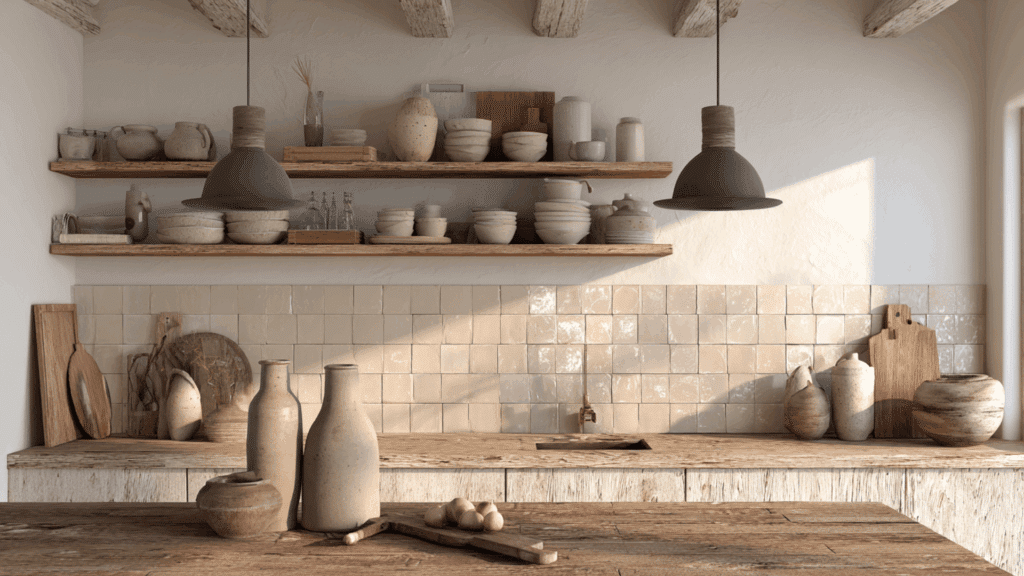
Open shelving showcases hand-thrown pottery and stoneware, turning functional items into attractive focal points within your cooking area. Weathered counters made from reclaimed wood pair beautifully with matte tiles in clay and warm white shades.
These intentionally imperfect surfaces give your kitchen genuine character that polished designs simply cannot match or replicate. Pendant fixtures combined with abundant natural daylight ensure visibility for meal preparation throughout morning and afternoon hours.
4. Bathroom
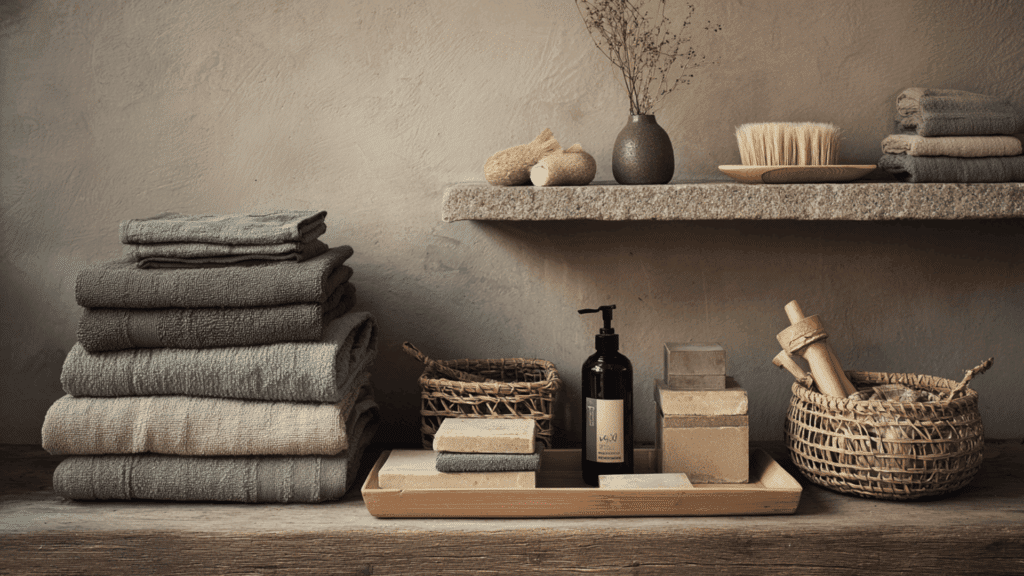
Textured stone walls provide tactile richness that immediately elevates this utilitarian space into something more soothing and special. Woven baskets and wooden trays organize essentials while introducing natural elements that effectively soften hard bathroom surfaces.
Bamboo, concrete, and linen work harmoniously to build layers of organic appeal across every corner and surface. Gray and sage hues dominate the color scheme while ambient lighting wraps everything in a calming, gentle radiance.
How Wabi-Sabi Differs from Other Interior Styles
Wabi-sabi shares similarities with other popular design styles but has unique qualities that set it apart from the rest. Understanding these differences helps you choose the approach that best matches your personal style and home goals:
| Aspect | Wabi-Sabi | Minimalism | Japandi |
|---|---|---|---|
| Philosophy | Finds peace in imperfection and natural aging | Seeks perfection through clean lines and strict order | Merges Japanese and Scandinavian principles |
| Overall Feel | Soft, inviting, emotionally warm | Cold, rigid, visually simple | Balanced warmth with functionality |
| Materials | Aged textures, raw, imperfect surfaces | Polished, sleek, flawless materials | Natural materials with refined finishes |
| Design Elements | Handmade items, organic shapes, asymmetry | Strict symmetry, geometric forms | Cleaner lines, more symmetry |
| Cultural Roots | Purely Japanese philosophy | Western modernist movement | Japanese and Scandinavian blend |
| Focal Point | Celebrates each piece’s story and history | Emphasizes visual simplicity and order | Focuses on functional beauty |
Each style offers distinct benefits depending on what atmosphere you want to create in your space. Choose minimalism for clean perfection, Japandi for functional warmth, or wabi-sabi for embracing natural imperfection and emotional depth.
Common Mistakes to Avoid in Wabi-Sabi Interiors
Even with good intentions, you can easily miss the mark when creating a wabi-sabi space at home. Avoiding these common errors will help you capture the true spirit of this beautiful design philosophy:
- Overstyling or forcing imperfection: This makes your space feel fake and staged instead of naturally aged and originally lived in.
- Using synthetic or overly polished materials: This goes against wabi-sabi principles because the style celebrates raw, natural textures with honest character.
- Confusing minimalism with emotional coldness: This creates sterile spaces that lack the warmth and soul that wabi-sabi design should bring.
- Cluttering the space with rustic decor: This misses the point entirely because wabi-sabi focuses on meaningful pieces rather than decorative excess.
Keep your approach simple and let natural beauty emerge without trying too hard to create it artificially. True wabi-sabi happens when you welcome what’s already there and honor the passage of time with respect.
Final Thoughts
Wabi sabi interior design invites you to slow down and appreciate the honest beauty that already exists around you. I hope this helps you see how welcoming imperfection can create spaces that feel more comfortable and real.
Start small by keeping aged furniture instead of replacing it or displaying handmade pottery that shows its unique character. Let natural light filter through your windows and choose materials that connect you to the earth beneath your feet.
Your home should reflect your life, complete with its gentle wear and meaningful history that makes it uniquely yours. What part of wabi sabi interior design speaks to you most? Share your thoughts in the comments below.














